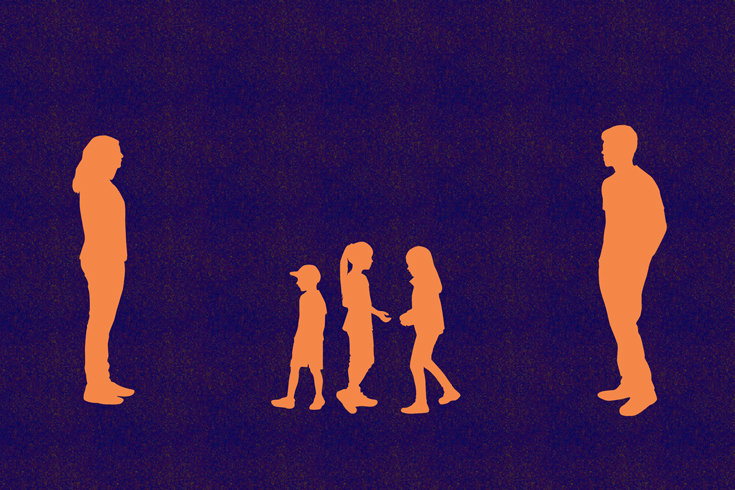We’ve got a blended family at my house. Both I and my husband had prior relationships and brought kids to the new unit. By now, we’re old hands at this: my two are off at university these days while my husband’s kids split their time equally between our house and their mother’s, as they have for almost a decade. But, when his boys came to our home March 16, we suddenly realized that, amid the ever-growing pandemic, we had no idea what protocols or recommendations were being followed at their other house. We simply hadn’t thought to ask.
Stores and restaurants were still open then, as the first presumed case of COVID-19 had only recently been announced in our home province of Newfoundland and Labrador—but, at our house, we were already days into the recommended social distancing. Coincidentally, I’d just read an account by a mother in quarantine in Italy. Among her parenting regrets? Allowing her kids to have social time in the early days of distancing protocol.
Even in an amicable divorce, there are bound to be the usual frictions: one house is looser on bedtime or screen time or homework. These are the normal challenges of co-parenting. In this time of social distancing, however, I’ve found myself with questions and concerns about what’s safe—and I know I can’t be the only one. Social media tells me that, as late as March 20, some families were still hosting get-togethers and play dates even though these were supposed to be off the table. We have a pretty low-key rhythm with the kids and their other house and normally these little frictions don’t feel terribly significant. But now, everything feels different and more fraught. The stakes are higher.
In our case, I’m the only caretaker available for my mother, who is seventy-six. She’s in good health but lives alone; I’m an only child, her go-to person. So I’m cautious about my own degree of isolation. I don’t want to make her sick.
Our two older children, from my previous marriage, are usually away at school, but the nineteen-year-old flew home on March 18 from his now-closed university campus. Assuming we stuck to our usual schedule, that would mean our two co-parented kids would be exposed to whatever he brought with him—and could potentially take it to their other house the following week. On the other hand, that same nineteen-year-old has asthma, which could put him in the “higher risk” category despite his youth. Whatever interactions happen at our kids’ other house, that exposure could come back here two weeks down the line.
Add to this that kids can be asymptomatic, making the contagion that much harder to detect. Indeed, one concern the provincial government in Newfoundland and Labrador had before closing schools was that, if parents were still at work, children might be sent to Nan and Pop’s house, where they could pass the illness on. According to a recent CBC article, “It’s estimated that every infected person passes the virus on to two others. The fewer social contacts each of us has, the fewer opportunities for the virus to jump from person to person.”
You see the difficulty: it’s easy to say “stay home,” but what if “home” is actually two different places and two different sets of circumstances? Suddenly, it’s no longer unimportant if the rules are different between the two houses, because what happens at their other house will have direct consequences for mine—and vice versa.
Marisa Creatore is the assistant scientific director of the CIHR Institute of Population and Public Health and a professor at the University of Toronto’s Dalla Lana School of Public Health. She was also my best friend in high school. I called her up.
Could kids like ours, I asked, travelling between their two houses, bring the virus along with them? She says yes. “Remember, the science is still new—every day, we are getting new information. The evidence looks like a large proportion of people who are infected are asymptomatic or only have mild symptoms. The risk in your household is going to be related to the other house.”
Creatore reaffirmed the standard guidelines: proper hand washing, social distancing, common sense. Where co-parenting is concerned, what’s important to remember is this: “The risk of both households is going to be that of the least adhering household because you have these vectors going back and forth in the form of the children.”
If we truly want to flatten the curve, or slow down the spread of this new virus, the community has to be on board. And, in this case, your community includes your ex-partner. Yet another thing for divorced parents to discuss and agree on. “That conversation has to happen,” says Creatore. “How are they adhering to social distancing? What precautions are they putting in place? And the kids should be included in that conversation. Without scaring them, they should be part of that.”
I’ll admit it: I’m not much for any kind of confrontation or conflict, and there’s an element here that might feel tinged with value judgment. This is new territory for all of us. No one wants to pick a fight about allowing kids to see their friends. But, if ever there’s been a time to take a deep breath and dive into a difficult conversation, surely it’s now. And maybe those recommended guidelines can be there for us to lean on.
The goal, Creatore says, is to “slow down transmission, yes, but we also have to get through this psychologically and emotionally, and part of what helps is having these consistent guidelines to follow and feeling some kind of control.” Common sense, post-divorce, always leads to this place: the best thing parents can do is get on the same page. “As parents, our job is to make sure that one consistent message comes across to the kids: this is something we can do, we can stick to this, and it’s all going to be fine.”
In our case, it’s easy for us to stay home—my husband and I are both writers, and his ex is a professor who can work remotely. What if one of these co-parents was a grocery store cashier or a paramedic or a nurse? I turned to social media. How were other parents handling this same challenge?
Divorced parents are used to the stress of juggling kids’ schedules, but the pandemic creates unprecedented burdens. “My ex is a teacher, so I’m golden for school closures,” said one parent, who works for a Newfoundland radio station. Her arrangement with her ex adapts to her changing work schedule. “He automatically takes our child because it’s understood that, when schools are closed, I’m working extra hard.” Like many of us in a co-parent situation, she is so used to it that she didn’t even blink: the kid just goes back and forth.
But, when I mentioned my real concerns—the challenge of keeping social distancing or self-isolation protocol when a kid moves between houses and the danger of a child becoming a conduit for the virus—she pulled up short, suddenly realizing the implications. “Oh dear. We have not communicated about this at all,” she said. “That will be something to discuss.”
That discussion came much sooner for one dad who reached out to me. A historian at a public college in New York, he was pushed to create a solid, open dialogue with his children’s mother because the situation had become so dire so quickly in New York City. “This is why I wanted to speak to you,” he tells me from his home in Manhattan. “I feel like an emissary from the future.” On March 6, he was at a concert with hundreds of other people. Three days later, he was teaching students how to wash their hands. Two days after that, they shut down his college campus. At first, he and his ex decided to keep the kids home, even before schools were closed. But, apart from that, they thought they would stick to their normal, predetermined schedule.
The following weekend, things changed. Their second big conversation happened just before the kids were due to return to his house from their mother’s. “It’s become clear that, after two weeks of being in isolation, you can be fairly sure you are not infected. But I had gone to Brooklyn to pick up my girlfriend, and my girls had been in school only days before. So, if we followed our schedule as usual, we were going to risk cross-infecting.”
The adults could potentially pass the virus on to the kids, or vice versa, before anyone began showing symptoms. The solution? A quick change to the schedule: the girls will stay at their mother’s house for an extra two weeks. He hopes to establish what he calls a “pod of people,” starting small, one pod at each house, before “merging the pods.”
Their thinking is that, if they can go two weeks of consistent social distancing without anyone showing symptoms, then at that point they would feel comfortable moving the girls back and forth. He’s aiming for a rhythm of one week on, one week off, to avoid chaos and create consistency for the kids. “The less frequently you have to move them, the lower the risk.”
One Nova Scotian parent who contacted me also wrote that flexibility is the way to go. Calling her situation “complex”—a blended family that includes lots of elderly relatives and an ex-partner who works with older people—she reported that her co-parented child is at an isolated family cottage with a few relatives and will stay there until further notice, even though this means missing scheduled weekends at Dad’s.
“The parenting relationship you have with your ex, whatever you have laid down in the past, is going to come into play now,” she wrote. In her case, the breakup was complicated and acrimonious, but she learned right away to bite her tongue “rather than grind any axes on the kids. So that’s served me well in the ensuing years. You have to touch base and really think about what’s best for the kids. That’s my North Star in all this.”
Communication and transparency seem to be the solution here. And, in some families, this whole topic must feel like a no-brainer. But, other times, that kind of open communication is easier said than done. People get divorced for a reason. When I recall the early days of my own separation and divorce, I don’t know how I could have handled a situation like COVID-19 without constant arguing; there would have been no guarantee of ever getting on the same page.
But I can see, too, how this piece of personal history has shaped my participation in the co-parenting relationship. Because I remember my own divorce as difficult, I tend to be hesitant. Avoidant, even. I literally moved halfway across the country, a good solution at the time. Now, as I push myself into the deep end of deeper conversation around our choices and lifestyles at both houses, I wonder how this experience might change me as a co-parent. How it might help me breach the awkwardness of discussing more mundane questions: piano and swimming lessons, homework prep, or curfews.
Like all crises, this one is revealing that more engagement and communication is better than less. In fact, in this case, better engagement won’t just be helpful: it will actually make us all safer. I’m sure this lesson will extend to emotional crises of other kinds—the weddings, babies, and non-virus-related events that are sure to come when this is all over. If I can talk out the tough stuff around COVID-19, there’s no excuse to avoid the day-to-day. Which is a real silver lining. Who knows? Maybe it takes a pandemic to raise a child.





